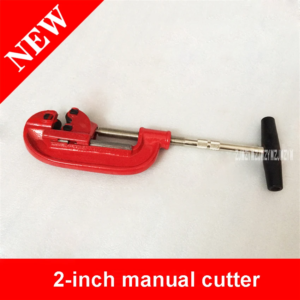A pipe cutter is a specialized tool used to cut pipes cleanly and accurately. It is commonly used in plumbing, HVAC (heating, ventilation, and air conditioning), and other industries where pipes need to be cut to specific lengths.
Types and Uses of Pipe Cutter
1. Manual Pipe Cutter
Design : This type of pipe cutter typically resembles a pair of pliers with a sharp wheel blade.
Operation : It requires physical effort to rotate the cutter around the pipe, scoring and eventually cutting through the material.
Use : Ideal for small-scale projects or when portability is needed.

2. Ratcheting Pipe Cutter
Design : These cutters have a ratcheting mechanism that allows for easier cutting by gripping and ratcheting around the pipe.
Operation : They require less physical effort compared to manual cutters and are suitable for thicker pipes.
Use : Commonly used in plumbing and construction due to their efficiency.

3. Rotary Pipe Cutter
Design : Utilizes a rotary cutting wheel powered by a drill or other power tool.
Operation : Offers precise cuts with minimal effort, speeding up the cutting process.
Use : Suitable for cutting thick-walled pipes or when a high volume of cuts is required.
4. Pipe Cutter for Plastic Pipes
Design : Specifically designed to cut plastic pipes such as PVC or PEX.
Operation : Uses a sharp blade to cleanly slice through plastic materials.
Use : Essential in plumbing and irrigation systems using plastic pipes.
!Plastic Pipe Cutter](https://example.com/plastic-pipe-cutter-image.jpg)
How to Use a Pipe Cutter
1. Preparation: Ensure the pipe is clean and free from debris.
2. Positioning : Place the pipe cutter around the pipe at the desired cutting point.
3. Cutting : For manual and ratcheting cutters, rotate the cutter around the pipe, gradually tightening until the pipe is cut. For rotary cutters, operate the tool per manufacturer instructions.
4. Finishing : Once cut, remove any burrs using a deburring tool for a smooth finish.
For watching video click below.
Uses of Pipe Cutters
Plumbing : Cutting pipes to fit specific lengths in residential and commercial plumbing installations.
Construction : Creating customized pipe lengths for HVAC systems, water supply lines, and drainage systems.
Maintenance : Repairing damaged pipes by cutting out the affected sections and replacing with new pipes.
DIY Projects : Useful for hobbyists and DIY enthusiasts working on home improvement projects involving pipes.
Benefits of Using Pipe Cutters
Precision : Provides clean, straight cuts without deforming the pipe.
Efficiency : Saves time compared to alternative cutting methods like sawing.
Portability : Manual and ratcheting cutters are lightweight and portable, suitable for on-site use.
Versatility : Available in various sizes and types to accommodate different pipe materials and diameters.
Safety Tips
– Always wear protective gear such as gloves and safety glasses.
– Follow manufacturer guidelines for the specific type of pipe cutter being used.
– Keep fingers clear of the cutting area to avoid injury.
Conclusion
Pipe cutters are indispensable tools in plumbing, construction, and maintenance industries, offering efficient and precise pipe cutting solutions. Whether for professional use or DIY projects, choosing the right type of pipe cutter ensures clean cuts and enhances workflow efficiency.

